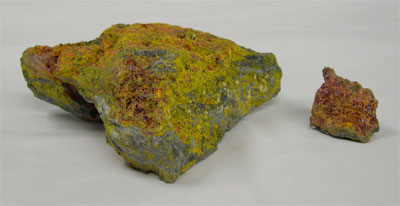What Is Arsenic?
Arsenic is an element and a naturally occurring mineral found widely in the environment.

Arsenic mineral ores, orpiment (left) and realgar (right).
Environmental sources of arsenic exposure are
- food,
- water,
- soil, and
- air.
Because it is an element, arsenic persists in the environment and does not deteriorate.
Arsenic production has greatly decreased in the United States, but imports of arsenic have increased steadily.
The most common valence states are
- As(0) (metalloid arsenic, 0 oxidation state),
- As(III) (trivalent, 3 oxidation state, such as arsenites),
- As(V) (pentavalent, 5 oxidation state, such as arsenates), and
- Arsine Gas (-3 oxidation state).
The relative toxicity of an arsenical depends primarily on
- inorganic or organic form,
- valence state,
- solubility,
- physical state and purity, and
- rates of absorption and elimination [ATSDR 2007].
The toxicity of arsenic compounds can vary greatly. In general, arsenic compounds can be ranked from highest to lowest toxicity:
- inorganic trivalent compounds,
- organic trivalent compounds,
- inorganic pentavalent compounds,
- organic pentavalent compounds, and
- elemental arsenic [Gorby 1988].
Inorganic arsenic is generally more toxic than organic arsenic. Forms of arsenic that are more rapidly absorbed are more toxic, while those most rapidly eliminated tend to be less toxic. Arsenite and arsenate forms are highly soluble in water.
Although organic arsenicals are usually viewed as being less toxic than the inorganics, several methyl and phenyl derivatives of arsenic that are widely used in agriculture are of possible health concern on the basis mostly of animal studies. Chief among these are monomethylarsonic acid (MMA) and its salts and dimethylarsinic acid (DMA) and its salts, and roxarsone [ATSDR 2007].
Arsenobetaine and Arsenocholine are the organic forms known as “fish arsenic” and are relatively nontoxic to humans.
Arsine gas is the most toxic arsenical (acute exposure).
- Arsenic is an element and is a naturally occurring mineral found widely in the environment.
- Arsenic exists in four common valence states.
- Arsenic is widely used commercially, a fact that increases the risk of overexposure. Workers may be overexposed occupationally to arsenic.
- Inorganic arsenic is generally more toxic than organic arsenic.